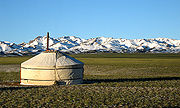
Gobi Gurvansaikhan National Park
Encyclopedia


Mongolia
Mongolia is a landlocked country in East and Central Asia. It is bordered by Russia to the north and China to the south, east and west. Although Mongolia does not share a border with Kazakhstan, its western-most point is only from Kazakhstan's eastern tip. Ulan Bator, the capital and largest...
. The park was established in 1993, and expanded to its current size in 2000. The park, at nearly 27,000 square kilometers, is the largest national park in Mongolia.
The park is named for the Gurvan Saikhan Mountains, which translates to the Three Beauties. The name is derived from three subranges, the East, Middle and West Beauty. The range forms the eastern half of the park.
The park lies on the northern edge of the Gobi desert
Gobi Desert
The Gobi is a large desert region in Asia. It covers parts of northern and northwestern China, and of southern Mongolia. The desert basins of the Gobi are bounded by the Altai Mountains and the grasslands and steppes of Mongolia on the north, by the Hexi Corridor and Tibetan Plateau to the...
. The higher elevations contain areas of steppe
Steppe
In physical geography, steppe is an ecoregion, in the montane grasslands and shrublands and temperate grasslands, savannas, and shrublands biomes, characterized by grassland plains without trees apart from those near rivers and lakes...
. A number of rare plants and animals are found in the park, including the elusive snow leopard
Snow Leopard
The snow leopard is a moderately large cat native to the mountain ranges of South Asia and Central Asia...
and the Gobi Camel
Bactrian camel
The Bactrian camel is a large, even-toed ungulate native to the steppes of central Asia. It is presently restricted in the wild to remote regions of the Gobi and Taklamakan Deserts of Mongolia and Xinjiang. A small number of wild Bactrian camels still roam the Mangystau Province of southwest...
. Areas of sand dunes are found, most famously the Khongoryn Els - the Singing Sands. Another major tourist destination is Yolyn Am
Yolyn Am
right|thumb|Remnants of the Yolyn Am ice field, September 2006Yolyn Am is a deep and narrow gorge in the Gurvan Saikhan Mountains of southern Mongolia. The valley is named after the Lammergeier, which is called Yol in Mongolian...
, a mountain valley that contains a large ice field through most of the year.
The park is usually accessed via the town of Dalanzadgad
Dalanzadgad
Dalanzadgad is the capital of Ömnögovi Aimag in Mongolia. It is located south of the national capital Ulaanbaatar. The altitude of the city center is 1,470 meters .As of 2006, its population is 14,000.-Transportation:...
, which has airport service to Ulaanbaatar
Ulaanbaatar
Ulan Bator or Ulaanbaatar is the capital and largest city of Mongolia. An independent municipality, the city is not part of any province, and its population as of 2008 is over one million....
.

